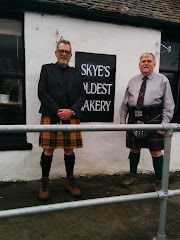There are countless theories as to the origin of Turkish coffee, that distinctive foamy coffee which is cooked slowly in its own special pot over a brazier then served in a tiny cup accompanied by a piece of Turkish delight or some other confectionery. According to some, coffee originated in the Ethiopian city of Kaffa. Others claim that coffee originated in Yemen where it was called "qahwaw" which means "strength" or "fitness" in Arabic.
There are also countless stories as to how it was discovered. The central figure of the most popular is a Yemeni shepherd named Kaldi whose goats began frolicking about excitedly after they had eaten some red berries from a tree. The shepherd was curious and related his story to the local wise men. These sages ate some of these berries as an experiment and discovered that they were able to stay awake easily throughout their all-night worship rituals. The wise men decided that this was truly a sacred medicine. They boiled it into a drink and also used it as a balm for sores. Coffee immediately became popular, particularly as alcohol was forbidden by Islamic teachings. Coffee beans shipped out of the Mocha harbor in Yemen, were also taking on an historic mission, and thus the world discovered the pleasures of drinking coffee.
Sjehab-eddin, a mufti (muhammedan priest) during a trip to Abessinia (now Ethiopia) in the middle of 1400 century, learned to know about the brew which made the need to sleep disappear. The brew had been used and been grown for ages in Abessinia and beyond in the land of Kaffa. Sjehab-Eddin saw that it was good and decided to take bushes back to his hometown Aden in the land known now as Yemen. He especially felt that the dervesch (muhammedan monks), could use the brew to easier manage their nightly meditations. There is also consensus that the first users of coffee were indeed the Sufis who used it as a stimulus to stay awake during late night Thikr "Zikir" (remembrance of God). Coffee spread to the rest of Muslims of Yemen and eventually to all the Muslim world through travellers, pilgrims and traders. It reached Makkah and Turkey sometime in the late 15th century and Cairo in the16th century.
This 'stimulating' effect caused influential religious leaders to forbid the drinking of coffee in 1511, because it had similarly damaging effects to alcohol. Within a very short time this led to the burning of all coffee stores and a ban on sales. But the actual reason for the ban was less the stimulating effect of coffee than the growing number of coffee houses, which were suspected of being the breeding ground for free political thinking. The spread of coffee was not to be stopped that easily, however. Mecca was the hub of many trading routes, so it was only a question of time until the beans also appeared in the big trading cities of Cairo, Damascus and Aleppo. The Yemeni port city of Al-Mukha, a flourishing Red Sea coast trading centre between the Middle East and India, became the main coffee shipping location. It is from here that the strong coffee of the Orient takes its name: mocha.
To make sure that they maintained their world monopoly on coffee, the Yemeni rulers prohibited the export of coffee plants. Only roasted or boiled coffee beans, which were no use for planting, could leave the country. Theft of the plants was heavily punished. This explains why, for a very long time, no country outside Yemen was able to cultivate coffee.
The Ottomans were first introduced to coffee when Ozdemir Pasha served the sultan Suleyman the Magnificent with coffee he had brought back from Yemen. In this same period, Ibrahim Bey of Pesevel reportedly said that "a man from Aleppo named Hakem and a woman from Damascus called Sems opened the first coffeehouse in Istanbul's Tahtakale."
Soon coffee drinking became popular and widespread throughout the nation. Although coffee itself originated in Ethiopia, because of the way the Turks both cooked and served it, it soon became known as " Turkish Coffee." In 1543, when the public began to frequent the coffeehouse more than the mosque, the Sheikh ul-Islam of the time issued a proclamation to the effect that "the juice of an object which is produced from something burned until it is coal-like is not religiously permissible." However, coffee maintained its popularity, despite the prohibitions, arrests, and even executions. Cultural events were common in Turkish coffeehouses, particularly the traditional Karagoz shadow puppets, troubadours, mimics and instrumentalists. The fame of coffee soon spread throughout Anatolia, Syria, Egypt, and Southeastern Europe. The beans reached France by 1669 and then to Venice. Even though the Church proclaimed coffee to be the " work of the devil ," Italian-style coffee soon became highly popular.
From the site http://maviboncuk.blogspot.com



Donn
ReplyDeleteI don't know alot about turkish coffe bur I am more familar with the Italian style espresso et al.
I know the church did condemm it but later the Pope which one I don't know decided to give it a try and liked it. Thus we have cappo foamy's. You know when the church was going to impose celebacy the Pope should have tried it out and might have liked it and we wouldn't have all this sinning in the shadows.
Whatever that means.
Donn liked the article
Michael Q
Excellent analogy, as a recovering Catholic, I applaud the news.
ReplyDelete